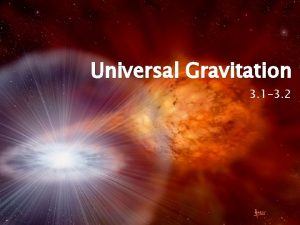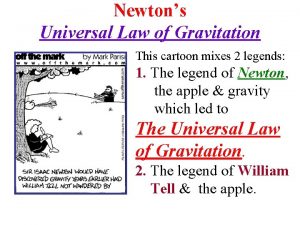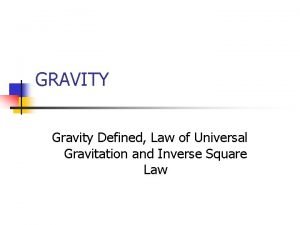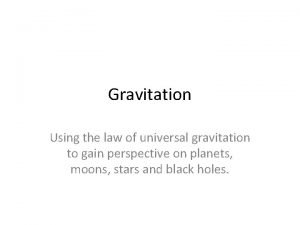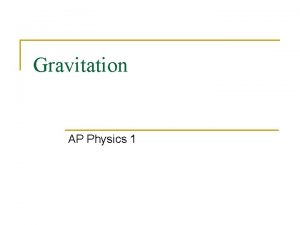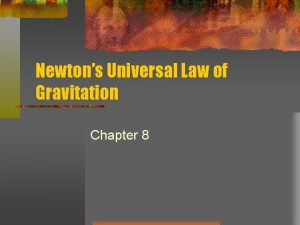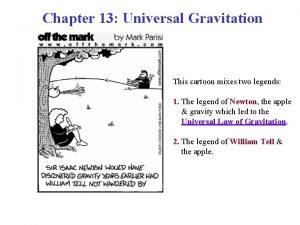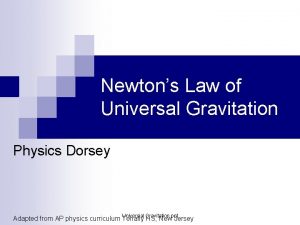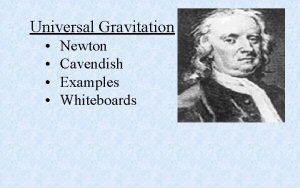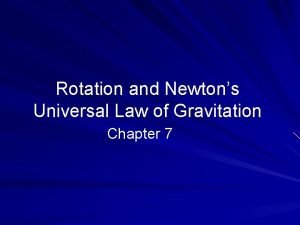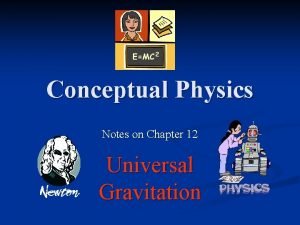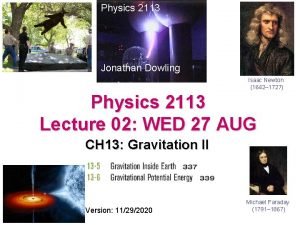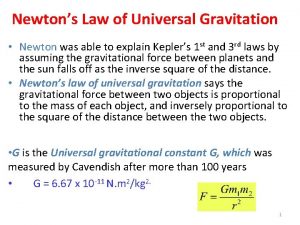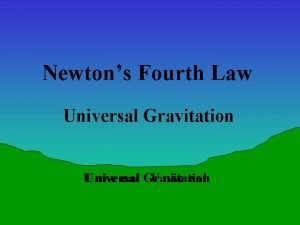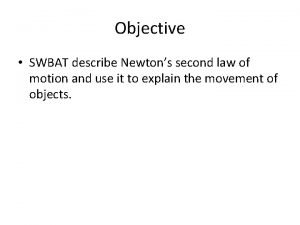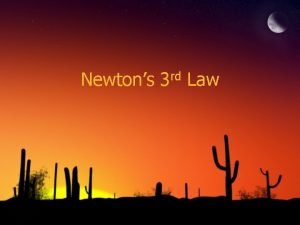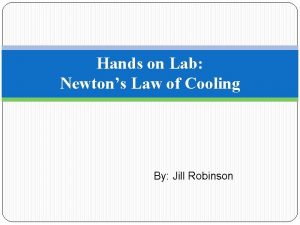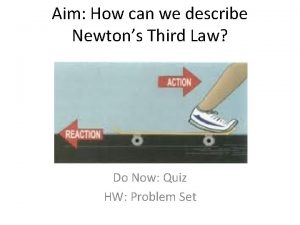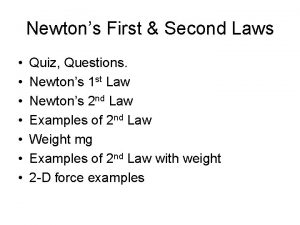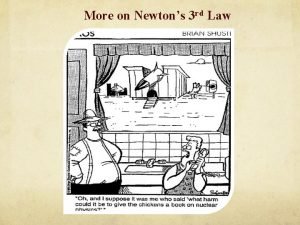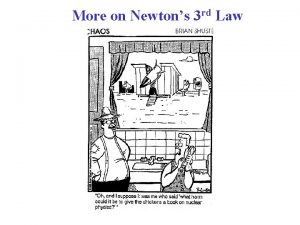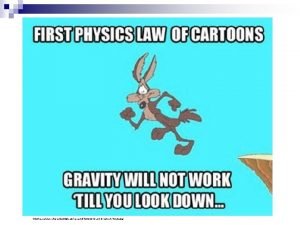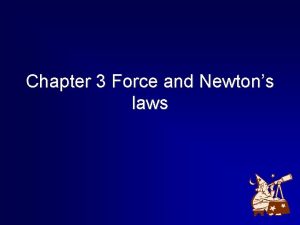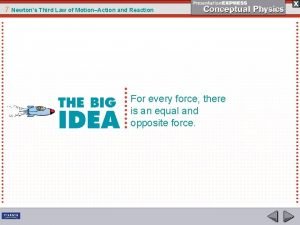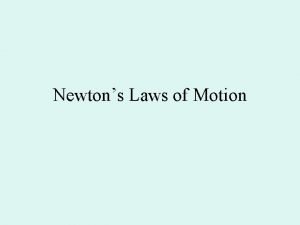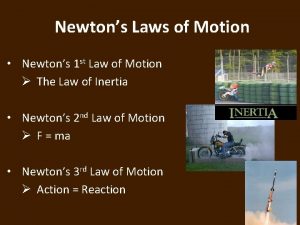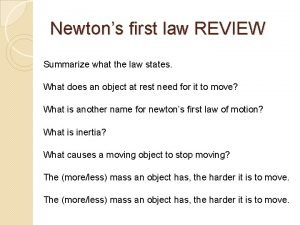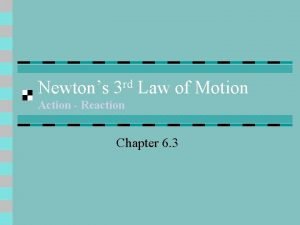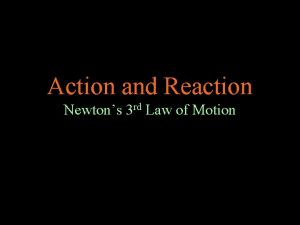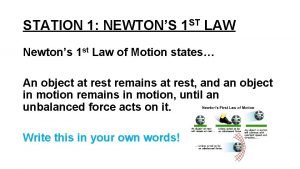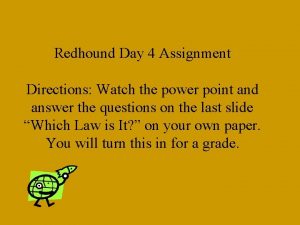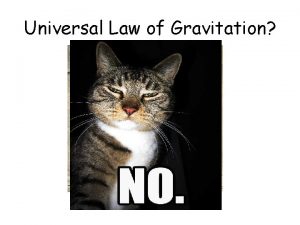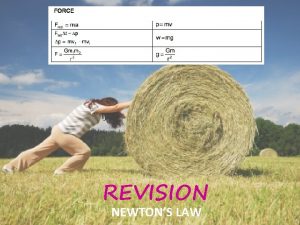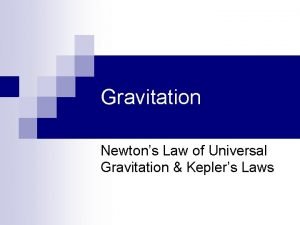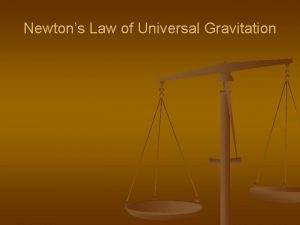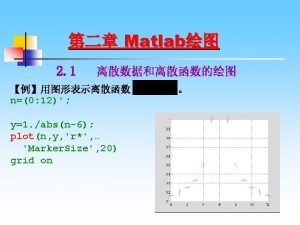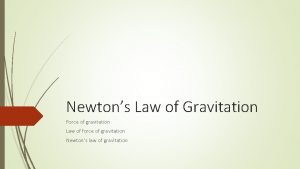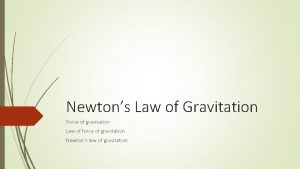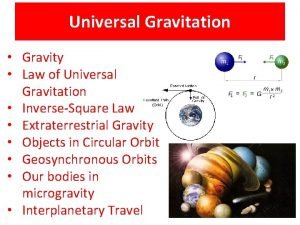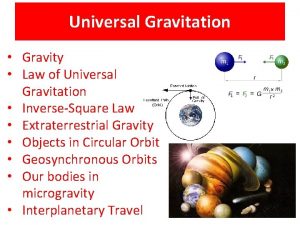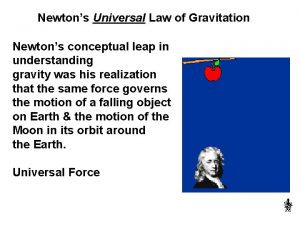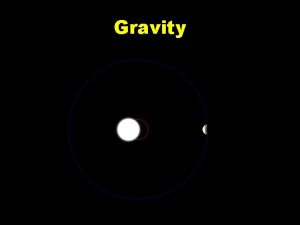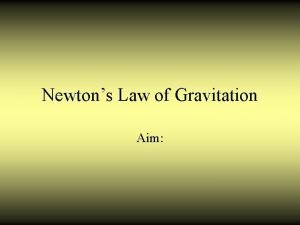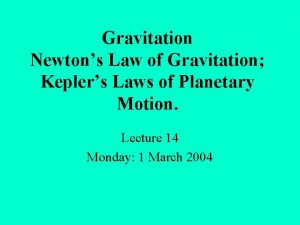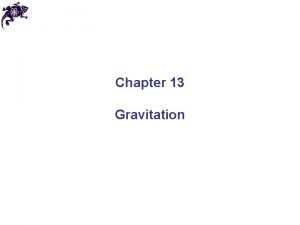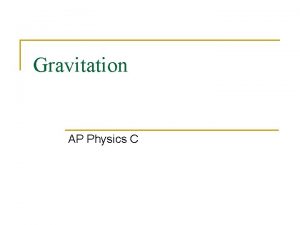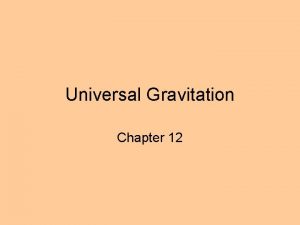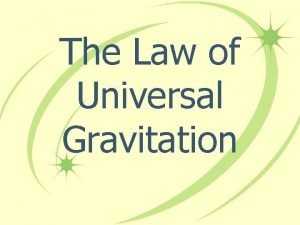Universal Gravitation Hold on Newtons Law of Universal















































- Slides: 47

Universal Gravitation Hold on

Newton’s Law of Universal Gravitation l Every particle in the Universe attracts every other particle with a force that is directly proportional to the product of their masses and inversely proportional to the distance between them l G is the universal gravitational constant and equals 6. 673 x 10 -11 N m 2 / kg 2

Finding the Value of G In 1789 Henry Cavendish measured G l The two masses are fixed at the ends of a light horizontal rod l Two large masses were placed near the small ones l The angle of rotation was measured l

Law of Gravitation, cont l This is an example of an inverse square law ¡ The magnitude of the force varies as the inverse square of the separation of the particles l The law can also be expressed in vector form ¡ The negative sign indicates an attractive force

Notation is the force exerted by particle 1 on particle 2 l The negative sign in the vector form of the equation indicates that particle 2 is attracted toward particle 1 l is the force exerted by particle 2 on particle 1 l

More About Forces l ¡ The forces form a Newton’s Third Law action -reaction pair Gravitation is a field force that always exists between two particles, regardless of the medium between them l The force decreases rapidly as distance increases l ¡ A consequence of the inverse square law

Gravitational Force Due to a Distribution of Mass l The gravitational force exerted by a finitesize, spherically symmetric mass distribution on a particle outside the distribution is the same as if the entire mass of the distribution were concentrated at the center l The force exerted by the Earth on a particle of mass m near the surface of the Earth is

G vs. g l Always distinguish between G and g l G is the universal gravitational constant ¡ It lg is the same everywhere is the acceleration due to gravity ¡g = 9. 80 m/s 2 at the surface of the Earth ¡ g will vary by location

Finding g from G The magnitude of the force acting on an object of mass m in freefall near the Earth’s surface is mg l This can be set equal to the force of universal gravitation acting on the object l

g Above the Earth’s Surface l If an object is some distance h above the Earth’s surface, r becomes RE + h l This shows that g decreases with increasing altitude l As r ® , the weight of the object approaches zero

Variation of g with Height

Johannes Kepler 1571 – 1630 l German astronomer l Best known for developing laws of planetary motion l ¡ Based on the observations of Tycho Brahe

Kepler’s Laws l Kepler’s First Law ¡ l Kepler’s Second Law ¡ l All planets move in elliptical orbits with the Sun at one focus The radius vector drawn from the Sun to a planet sweeps out equal areas in equal time intervals Kepler’s Third Law ¡ The square of the orbital period of any planet is proportional to the cube of the semimajor axis of the elliptical orbit

Notes About Ellipses l F 1 and F 2 are each a focus of the ellipse ¡ ¡ They are located a distance c from the center The sum of r 1 and r 2 remains constant l l Use the active figure to vary the values defining the ellipse The longest distance through the center is the major axis ¡ a is the semimajor axis

Notes About Ellipses, cont l The shortest distance through the center is the minor axis ¡ l b is the semiminor axis The eccentricity of the ellipse is defined as e = c /a ¡ ¡ ¡ For a circle, e = 0 The range of values of the eccentricity for ellipses is 0 < e < 1 The higher the value of e, the longer and thinner the ellipse

Notes About Ellipses, Planet Orbits l The Sun is at one focus ¡ l Nothing is located at the other focus Aphelion is the point farthest away from the Sun ¡ The distance for aphelion is a + c l l For an orbit around the Earth, this point is called the apogee Perihelion is the point nearest the Sun ¡ The distance for perihelion is a – c l For an orbit around the Earth, this point is called the perigee

Kepler’s First Law A circular orbit is a special case of the general elliptical orbits l Is a direct result of the inverse square nature of the gravitational force l Elliptical (and circular) orbits are allowed for bound objects l ¡ ¡ A bound object repeatedly orbits the center An unbound object would pass by and not return l These objects could have paths that are parabolas (e = 1) and hyperbolas (e > 1)

Orbit Examples l Mercury has the highest eccentricity of any planet (a) ¡ l Halley’s comet has an orbit with high eccentricity (b) ¡ l e. Mercury = 0. 21 e. Halley’s comet = 0. 97 Remember nothing physical is located at the second focus ¡ The small blue dot

Kepler’s Second Law Is a consequence of conservation of angular momentum l The force produces no torque, so angular momentum is conserved l l l Use the active figure to vary the value of e and observe the orbit

Kepler’s Second Law, cont. l Geometrically, in a time dt, the radius vector r sweeps out the area d. A, which is half the area of the parallelogram l Its displacement is given by

Kepler’s Second Law, final l Mathematically, l The we can say radius vector from the Sun to any planet sweeps out equal areas in equal times l The law applies to any central force, whether inverse-square or not

Kepler’s Third Law Can be predicted from the inverse square law l Start by assuming a circular orbit l The gravitational force supplies a centripetal force l Ks is a constant l

Kepler’s Third Law, cont l This can be extended to an elliptical orbit l Replace r with a ¡ Remember l Ks a is the semimajor axis is independent of the mass of the planet, and so is valid for any planet

Kepler’s Third Law, final l If an object is orbiting another object, the value of K will depend on the object being orbited l For example, for the Moon around the Earth, KSun is replaced with KEarth

Example, Mass of the Sun l Using the distance between the Earth and the Sun, and the period of the Earth’s orbit, Kepler’s Third Law can be used to find the mass of the Sun l Similarly, the mass of any object being orbited can be found if you know information about objects orbiting it

Example, Geosynchronous Satellite A geosynchronous satellite appears to remain over the same point on the Earth l The gravitational force supplies a centripetal force l You can find h or v l

The Gravitational Field l. A gravitational field exists at every point in space l When a particle of mass m is placed at a point where the gravitational field is , the particle experiences a force l The field exerts a force on the particle

The Gravitational Field, 2 l The gravitational field is defined as The gravitational field is the gravitational force experienced by a test particle placed at that point divided by the mass of the test particle l The presence of the test particle is not necessary for the field to exist l The source particle creates the field l

The Gravitational Field, 3 The gravitational field vectors point in the direction of the acceleration a particle would experience if placed in that field l The magnitude is that of the freefall acceleration at that location l

The Gravitational Field, final l The gravitational field describes the “effect” that any object has on the empty space around itself in terms of the force that would be present if a second object were somewhere in that space

Gravitational Potential Energy l The gravitational force is conservative l The change in gravitational potential energy of a system associated with a given displacement of a member of the system is defined as the negative of the work done by the gravitational force on that member during the displacement

Gravitational Potential Energy, cont l As a particle moves from A to B, its gravitational potential energy changes by DU

Gravitational Potential Energy for the Earth l Choose the zero for the gravitational potential energy where the force is zero ¡ This means Ui = 0 where ri = ∞ is valid only for r ≥ RE and not valid for r < RE ¡ U is negative because of the choice of Ui

Gravitational Potential Energy for the Earth, cont Graph of the gravitational potential energy U versus r for an object above the Earth’s surface l The potential energy goes to zero as r approaches infinity l

Gravitational Potential Energy, General l For any two particles, the gravitational potential energy function becomes l The gravitational potential energy between any two particles varies as 1/r ¡ l Remember the force varies as 1/r 2 The potential energy is negative because the force is attractive and we chose the potential energy to be zero at infinite separation

Gravitational Potential Energy, General cont l An external agent must do positive work to increase the separation between two objects ¡ The work done by the external agent produces an increase in the gravitational potential energy as the particles are separated l U becomes less negative

Systems with Three or More Particles The total gravitational potential energy of the system is the sum over all pairs of particles l Gravitational potential energy obeys the superposition principle l

Systems with Three or More Particles, cont Each pair of particles contributes a term of U l Assuming three particles: l l The absolute value of Utotal represents the work needed to separate the particles by an infinite distance

Energy and Satellite Motion l Assume an object of mass m moving with a speed v in the vicinity of a massive object of mass M ¡M >> l Also m assume M is at rest in an inertial reference frame l The total energy is the sum of the system’s kinetic and potential energies

Energy and Satellite Motion, 2 l Total l In energy E = K +U a bound system, E is necessarily less than 0

Energy in a Circular Orbit An object of mass m is moving in a circular orbit about M l The gravitational force supplies a centripetal force l

Energy in a Circular Orbit, cont l The total mechanical energy is negative in the case of a circular orbit l The kinetic energy is positive and is equal to half the absolute value of the potential energy l The absolute value of E is equal to the binding energy of the system

Energy in an Elliptical Orbit l For an elliptical orbit, the radius is replaced by the semimajor axis l The total mechanical energy is negative l The total energy is constant if the system is isolated

Escape Speed from Earth An object of mass m is projected upward from the Earth’s surface with an initial speed, vi l Use energy considerations to find the minimum value of the initial speed needed to allow the object to move infinitely far away from the Earth l

Escape Speed From Earth, cont l This minimum speed is called the escape speed Note, vesc is independent of the mass of the object l The result is independent of the direction of the velocity and ignores air resistance l

Escape Speed, General l The Earth’s result can be extended to any planet l The table at right gives some escape speeds from various objects

Escape Speed, Implications l Complete escape from an object is not really possible ¡ The gravitational field is infinite and so some gravitational force will always be felt no matter how far away you can get l This explains why some planets have atmospheres and others do not ¡ Lighter molecules have higher average speeds and are more likely to reach escape speeds
 Explain newton’s universal law of attraction/gravitation.
Explain newton’s universal law of attraction/gravitation. Vector form of gravitational force
Vector form of gravitational force Acceleration due to gravity
Acceleration due to gravity Gravity
Gravity Tension at highest point in vertical circle
Tension at highest point in vertical circle Universal gravitation law
Universal gravitation law Universal law of gravitation calculator
Universal law of gravitation calculator Newton's universal law of gravitation ap physics 1
Newton's universal law of gravitation ap physics 1 Newton's universal law of gravitation simplified
Newton's universal law of gravitation simplified Chapter 13 universal gravitation
Chapter 13 universal gravitation Law of universal gravitation ppt
Law of universal gravitation ppt Law of universal gravitation kid definition
Law of universal gravitation kid definition State newton's law of gravitation
State newton's law of gravitation Conceptual physics chapter 13 universal gravitation
Conceptual physics chapter 13 universal gravitation Gauss law in gravitation
Gauss law in gravitation Newton's law of gravitation
Newton's law of gravitation Newtons 4th law
Newtons 4th law Newtons 3 rd law of motion
Newtons 3 rd law of motion Newtons second law in soccer
Newtons second law in soccer Describe newtons second law
Describe newtons second law Example of first law of motion
Example of first law of motion Newtons 3 rd law of motion
Newtons 3 rd law of motion Newtons 3 laws
Newtons 3 laws Newton's 3 law
Newton's 3 law Newtons 3 rd law
Newtons 3 rd law Newton's law of cooling differential equation
Newton's law of cooling differential equation Describe newtons third law
Describe newtons third law Newton's third law of thermodynamics
Newton's third law of thermodynamics Difference between weight and mass
Difference between weight and mass Chapter 8 ask newton
Chapter 8 ask newton Newton's first and second law quiz
Newton's first and second law quiz Rd law
Rd law Newtons 3 rd law
Newtons 3 rd law What is reaction force
What is reaction force Newtons 3 rd law
Newtons 3 rd law Is normal force always equal to weight
Is normal force always equal to weight Newtons first law of motion meme
Newtons first law of motion meme Section 3 using newtons law
Section 3 using newtons law Newton's 3 laws of motion
Newton's 3 laws of motion Newtons third law of motion
Newtons third law of motion Newton's second law
Newton's second law What does f=ma mean
What does f=ma mean Newtons 1 st law
Newtons 1 st law Force and newtons law review
Force and newtons law review Newtons 3 rd law of motion
Newtons 3 rd law of motion Newtons 3 rd law of motion
Newtons 3 rd law of motion Newton's 1st law of motion
Newton's 1st law of motion Newtons 3 laws
Newtons 3 laws
